انواع مدل های برنامه ریزی استراتژیک ( Strategic Planning Models To Consider)
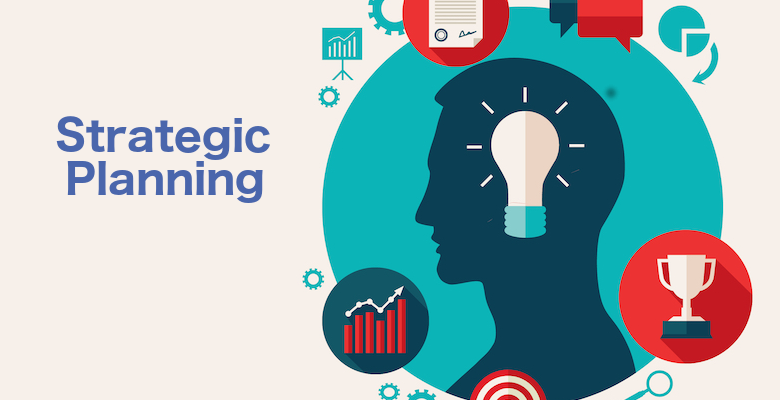
Strategic planning tools, or models, are designed to help organizations' develop their action plan to achieve their goals. There are a lot of strategic planning models out there. We know. Which is why we pulled together a list of 20+ of the most popular ones and describe the scenario that they are most useful.
I’m willing to bet one of these situations sounds familiar:
The strategy at your organization is nonexistent, and you’re assigned to find a strategic planning model so that you can kick off your strategic planning process.
Your company-wide strategy is in place, but entirely ineffective—and you have a hunch that using a strategic planning model (and strategy software) will make a big difference.
Your organization-wide strategy is fine, but there’s one area in your business environment (or internal process) that needs to be realigned with your strategy.
If you can identify with one of these scenarios, this article is for you!
Read through each of the models or find the ones you're looking for from the list below and jump right to them.
Table of Contents: Agile Project Management For Beginners
1. Balanced Scorecard
2. Strategy Map
3. SWOT Analysis
4. PEST Model
5. Gap Planning
6. Blue Ocean Strategy
7. Porter's Five Forces
8. VRIO Framework
9. Baldrige Framework
10. OKRs (Objectives and Key Results)
11. Hoshin Planning
12. Issue-Based Strategic Planning
13. Goal-Based Strategic Planning
14. Alignment Strategic Planning Model
15. Organic Models of Strategic Planning
16. Real-Time Strategic Planning
17.The basic model of strategic planning
18.The scenario model
19.McKinsey’s Strategic Horizons
20.The Bryson Model or Strategy Change Cycle
+
21.Other Planning Models and Frameworks
1. Balanced Scorecard
The Balanced Scorecard is a strategy management framework created by Drs. Robert Kaplan and David Norton. It takes into account your:
Objectives, which are high-level organizational goals.
Measures, which help you understand if you’re accomplishing your objective strategically.
Initiatives, which are key action programs that help you achieve your objectives.
There are many ways you can create a Balanced Scorecard, including using a program like Excel, Google Sheets, or PowerPoint or using reporting software.
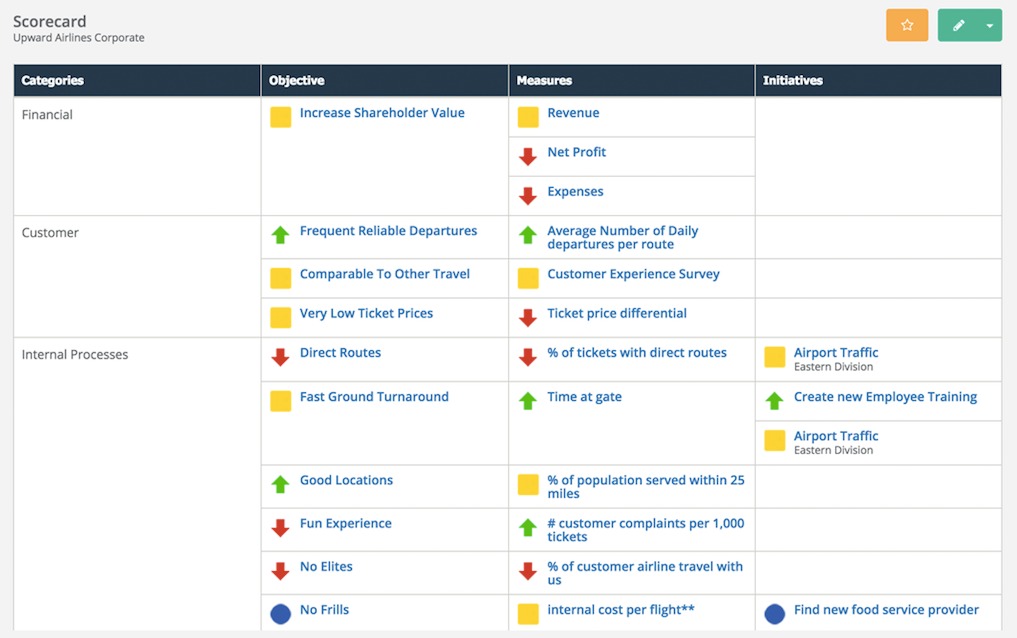
This is just one of the many “views” you’d be able to see in scorecard software once your BSC was complete. It gives you high-level details into your measures and initiatives and allows you to drill down into each by clicking on them. At a glance, you can tell what the RAG status of each objective, measure, or initiative is. (Green indicates everything is going as planned, while yellow and red indicate that there are various degrees of trouble with whatever is being looked at.)
All in all, a Balanced Scorecard is an effective, proven way to get your team on the same page with your strategy.
2. Strategy Map
A strategy map is a visual tool designed to clearly communicate a strategic plan and achieve high-level business goals. Strategy mapping is a major part of the Balanced Scorecard (though it isn’t exclusive to the BSC) and offers an excellent way to communicate the high-level information across your organization in an easily-digestible format.
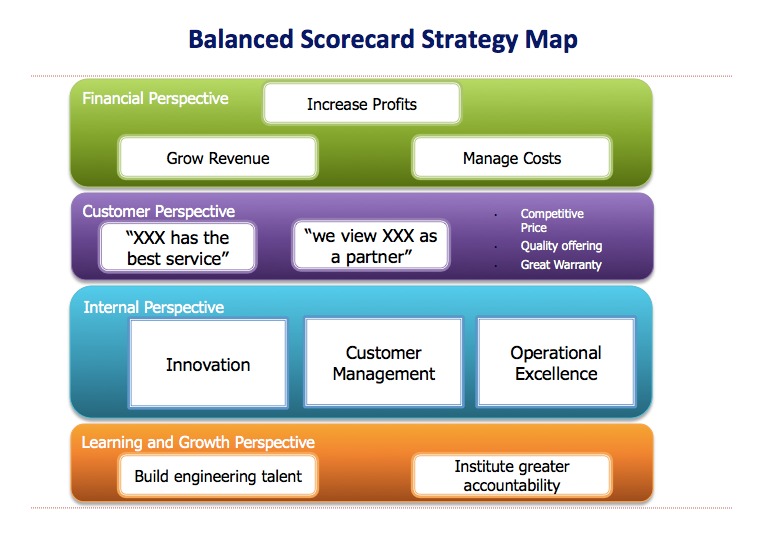
A strategy map offers a host of benefits:
It provides a simple, clean, visual representation that is easily referred back to.
It unifies all goals into a single strategy.
It gives every employee a clear goal to keep in mind while accomplishing tasks and measures.
It helps identify your key goals.
It allows you to better understand which elements of your strategy need work.
It helps you see how your objectives affect the others.
3. SWOT Analysis
A SWOT analysis (or SWOT matrix) is a high-level model used at the beginning of an organization’s strategic planning. It is an acronym for “strengths, weaknesses, opportunities, and threats.” Strengths and weaknesses are considered internal factors, and opportunities and threats are considered external factors.
Below is an example SWOT analysis from the Queensland, Australia, government:
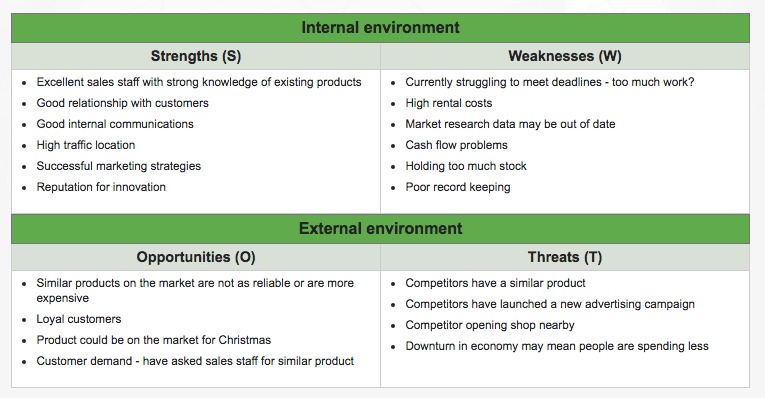
Using a SWOT analysis helps an organization identify where they’re doing well and in what areas they can improve. If you’re interested in reading more, this Business News Daily article offers some additional details about each area of the SWOT analysis and what to look for when you create one.
4. PEST Model
Like SWOT, PEST is also an acronym—it stands for “political, economic, sociocultural, and technological.” Each of these factors is used to look at an industry or business environment, and determine what could affect an organization’s health. The PEST model is often used in conjunction with the external factors of a SWOT analysis. You may also run into Porter’s Five Forces (see #7 below), which is a similar take on examining your business from various angles.
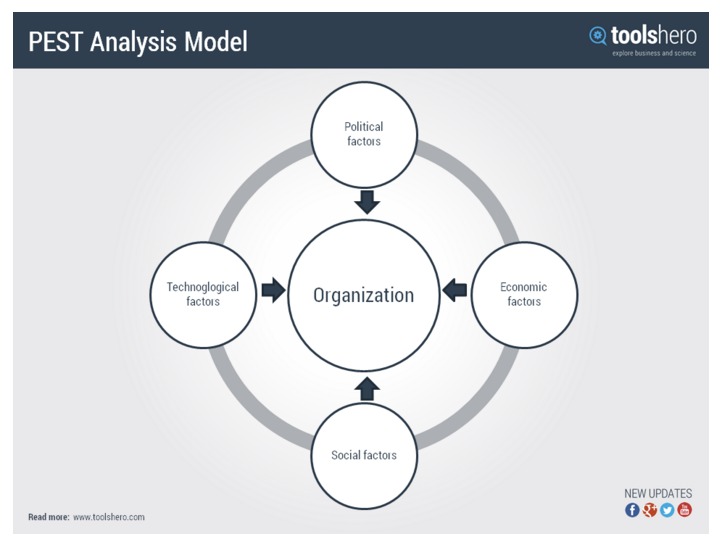
You’ll occasionally see the PEST model with a few extra letters added on. For example, PESTEL (or PESTLE) indicates an organization is also considering “environmental” and “legal” factors. STEEPLED is another variation, which stands for “sociocultural, technological economic, environmental, political, legal, education, and demographic.”
5. Gap Planning
Gap planning is also referred to as a “Need-Gap Analysis,” “Need Assessment,” or “the Strategic-Planning Gap.” It is used to compare where an organization is now, where it wants to be, and how to bridge the gap between. It is primarily used to identify specific internal deficiencies.
In your gap planning research, you may also hear about a “change agenda” or “shift chart.” These are similar to gap planning, as they both take into consideration the difference between where you are now and where you want to be along various axes. From there, your planning process is about how to ‘close the gap.’
The chart below, for example, demonstrates the difference between the projected and desired sales of a mock company:
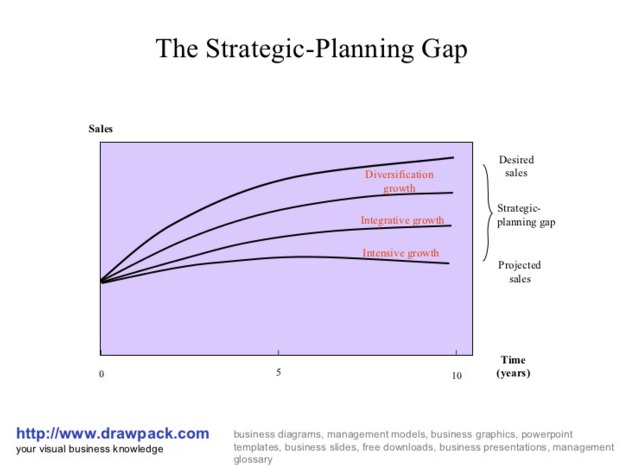
6. Blue Ocean Strategy
Blue Ocean Strategy is a strategic planning model that emerged in a book by the same name in 2005. The book—titled “Blue Ocean Strategy: How to Create Uncontested Market Space and Make Competition Irrelevant”—was written by W. Chan Kim and Renée Mauborgne, professors at the European Institute of Business Administration (INSEAD).
The idea behind Blue Ocean Strategy is for organizations to develop in “uncontested market space” (e.g. a blue ocean) instead of a market space that is either developed or saturated (e.g. a red ocean). If your organization is able to create a blue ocean, it can mean a massive value boost for your company, its buyers, and its employees.
For example, Kim and Mauborgne explain via their 2004 Harvard Business Review article how Cirque du Soleil didn’t attempt to operate as a normal circus, and instead carved out a niche for itself that no other circus had ever tried.
Below is a simple comparison chart from the Blue Ocean Strategy website that will help you understand if you’re working in a blue ocean or a red ocean:
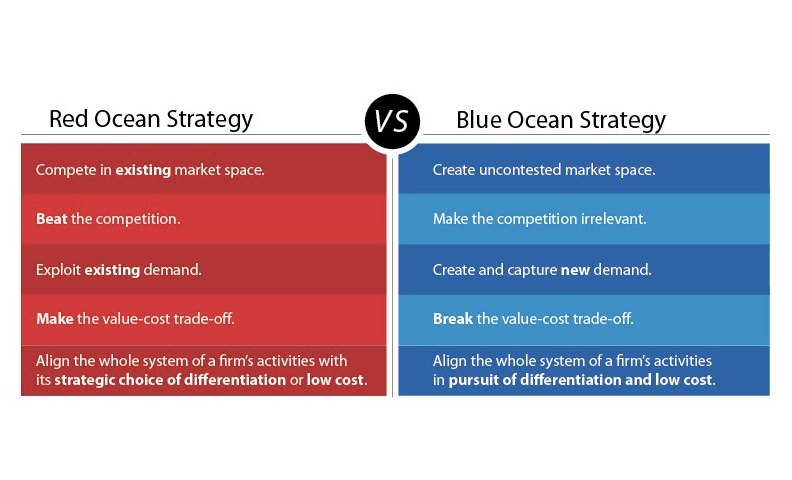
7. Porter’s Five Forces
Porter’s Five Forces is an older strategy execution framework (created by Michael Porter in 1979) built around the forces that impact the profitability of an industry or a market. The five forces it examines are:
The threat of entry. Could other companies enter the marketplace easily, or are there numerous entry barriers they would have to overcome?
The threat of substitute products or services. Can buyers easily replace your product with another?
The bargaining power of customers. Could individual buyers put pressure on your organization to, say, lower costs?
The bargaining power of suppliers. Could large retailers put pressure on your organization to drive down the cost?
The competitive rivalry among existing firms. Are your current competitors poised for major growth? If one launches a new product or files a new patent—could that impact your company?
The amount of pressure on each of these forces can help you determine how future events will impact the future of your company.
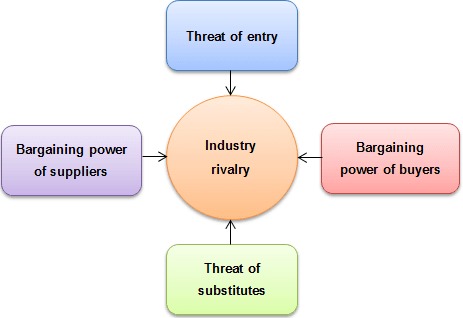
8. VRIO Framework
The VRIO framework is an acronym for “value, rarity, imitability, organization.” This strategic planning process relates more to your vision statement than your overall strategy. The ultimate goal in implementing the VRIO model is that it will result in a competitive advantage in the marketplace.
Here’s how to think of each of the four VRIO components:
Value: Are you able to exploit an opportunity or neutralize an outside threat using a particular resource?
Rarity: Is there a great deal of competition in your market, or do only a few companies control the resource referred to above?
Imitability: Is your organization’s product or service easily imitated, or would it be difficult for another organization to do so?
Organization: Is your company organized enough to be able to exploit your product or resource?
Once you answer these four questions, you’ll be able to formulate a more precise vision statement to help carry you through all the additional strategic elements in your plan.
9. Baldrige Framework
The Malcolm Baldrige National Quality Award is “the highest level of national recognition for performance excellence that a U.S. organization can receive.” Created in 1987, the goal of Baldrige is to help organizations innovate and improve, while achieving their mission and vision. The award is currently open to manufacturing, service, small business, nonprofit, government, education, and healthcare sectors.
When applying to win the Baldrige award at the national level, organizations undergo a competitive process that involves the implementation of the Baldrige framework. The framework outlines the “Baldrige Criteria For Performance Excellence,” where organizations must demonstrate achievement and improvement to an independent board of examiners in these seven areas:
Leadership
Planning and strategy
Customers
Measurement, analysis, and knowledge management
Workforce
Process
Results
To implement the Baldrige framework in your organization, start with two questionnaires that help you self-assess based on the seven Baldrige Criteria categories, and get a snapshot of your strengths and opportunities for improvement.
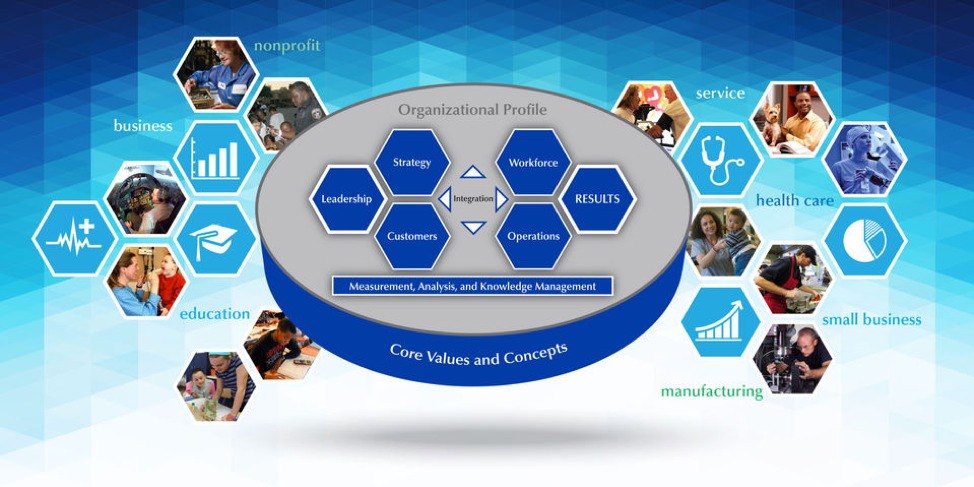
10. OKRs (Objectives and Key Results)
The strategic planning model of choice for Google, Intel, Spotify, Twitter, LinkedIn, and many other Silicon Valley successes, the OKR framework, is one of the more straightforward strategic planning tools. It’s designed to create alignment and engagement around measurable goals by clearly defining:
Objectives: What you want to achieve. Choose three to five objectives that are brief, inspiring, and time-bound.
Key Results: How you’ll measure progress toward your achievements. Set three to five key results (they must be quantitative) per objective.
This model is effective in part because of its simplicity; it also employs a “reverse” hierarchy that works to gain buy-in and alignment from the ground up. You begin by setting OKRs at the employee level and then flow upward through the management levels. The OKR framework is also effective because goals are continually set, tracked, and re-evaluated so organizations can quickly adapt when needed. This is a fast-paced, iterative approach that flips the traditional top-down strategic models. The RACI matrix is a helpful visual for defining the role each person in your organization has for projects and processes, ensuring it aligns with their OKRs.
Objective and Key Results OKR definition
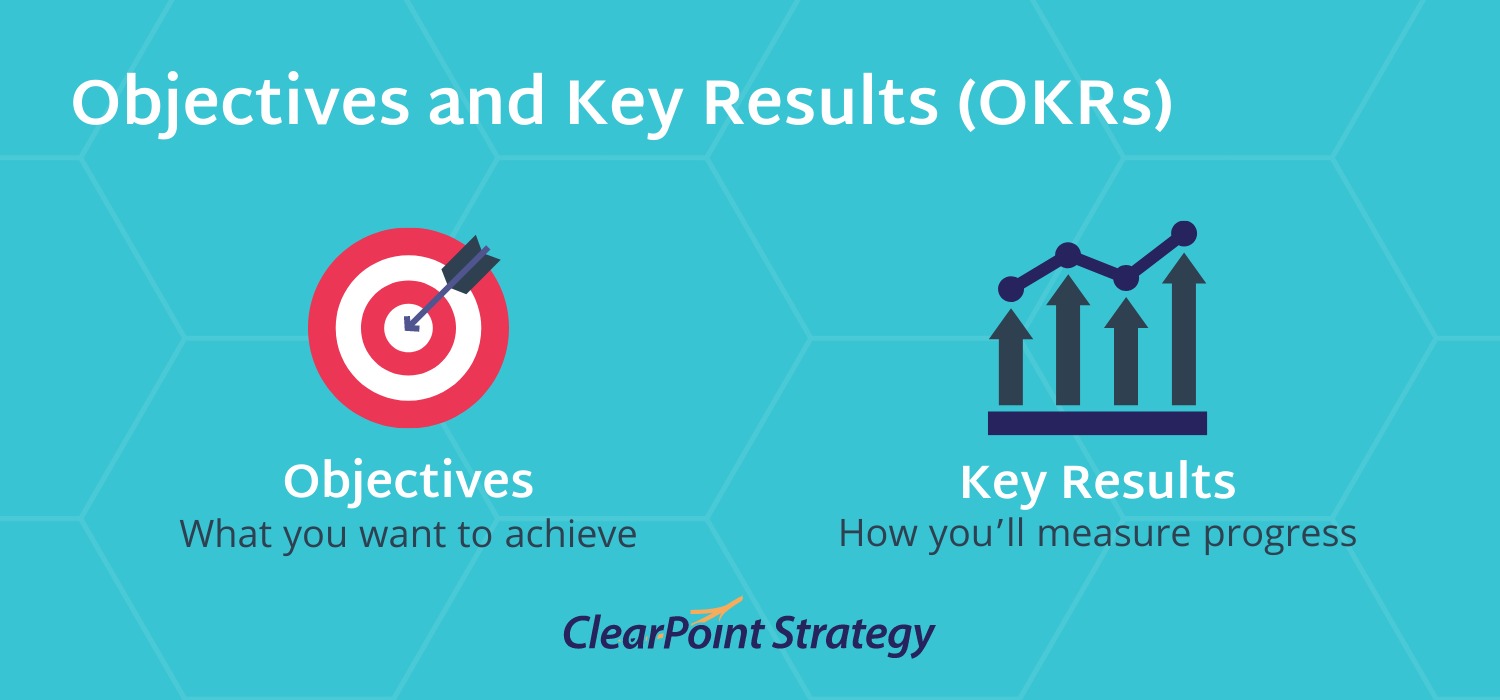
11. Hoshin Planning
The Hoshin Planning approach aligns your strategic goals with your projects and tasks to ensure that efforts are coordinated. This strategic management model is less focused on measures and more on goals and initiatives.
Some sources cite up to seven steps in the Hoshin Planning model, but the four most critical are:
Identify key goals. Ideally you’d focus on three to five goals.
Play “catchball.” Share goals from top to bottom of your organization to obtain buy-in.
Gather intel through “gemba.” Track the execution of your key goals and gather feedback from employees, using a defined process.
Make adjustments. Initiate change based on feedback and repeat the steps of catchball and gemba.
You visualize your objectives, measures and targets, measure programs, and action items in a Hoshin Planning matrix. Four directional quadrants (north, south, east, west) inform each other and demonstrate alignment.
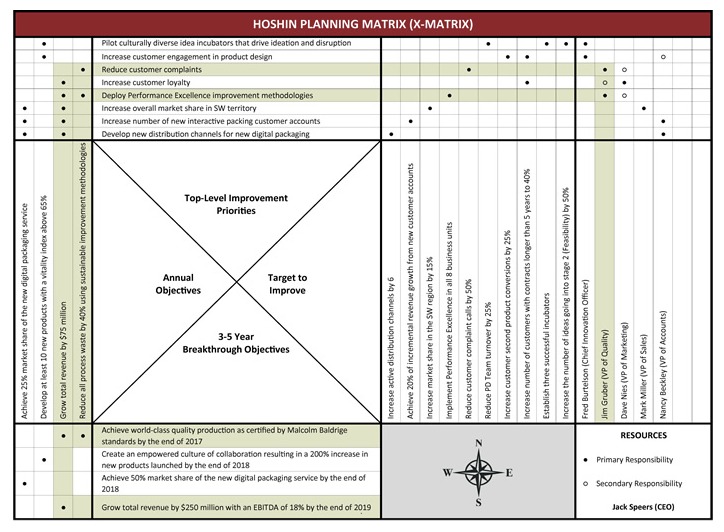
12. Issue-Based Strategic Planning
The issue-based strategic model is oriented in the present and projects into the future. It aims to identify the major challenges your organization faces now—in other words, you start with the problems to iron out issues before expanding, shifting your strategy, etc. This is typically a short-term (6-12 months), internally-focused process. Issue-based planning is ideal for young or resource-restricted organizations.
The leadership team or stakeholders identify the major issues and goals as a first step. Next, your organization will create action plans to address the issues, including budget allocation. From there, you will execute and track progress. After an issues-based plan has been implemented and the major issues you identified are resolved, then your organization might consider shifting to a broader, more complex strategic management model.
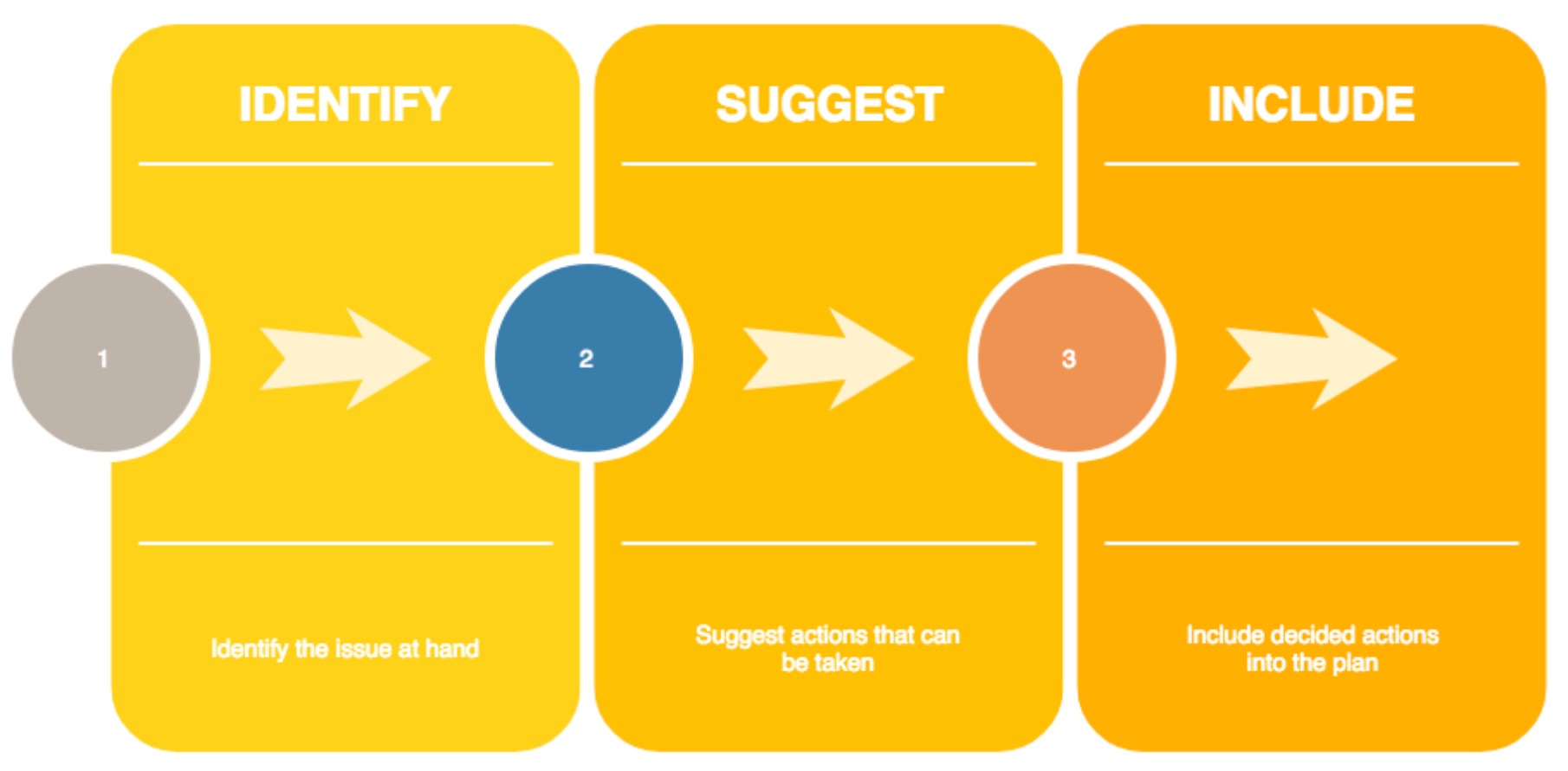
13. Goal-Based Strategic Planning
Goal-based strategic planning is the reverse of issue-based. This approach works backward from the future to the present. It all starts with your organization’s vision.
By nature, vision statements are aspirational and forward-thinking, but they need specifics in order to be realized. Goal-based planning tackles that challenge by setting measurable goals that align with your vision and strategic plan. Next, you define time frames for goal achievement. This is a long-term strategic planning tool, so goal time frames are typically about three to five years. From there, stakeholders will create action plans for each goal and begin tracking and measuring progress.
You want your department to be able to see their goals and the steps to achieve them. Use a Department Business Plan Dashboard
14. Alignment Strategic Planning Model
Similar to issue-based planning, the alignment model focuses on first looking internally to develop a strategy. This model is designed to sync the organization’s internal operations with its strategic goals.
Your strategic planning will start by identifying a goal and analyzing which operations or resources need to be aligned with that goal. Then you’ll identify which parts of operations are working well and which are not, brainstorming ideas from the successful aspects on how to address problems. Finally, you’ll create a series of proposed changes to operations or processes to achieve goals that will create the desired strategic alignment. The alignment strategic planning model is particularly useful when a company needs to refine its objectives or address ongoing challenges or inefficiencies that are blocking progress.
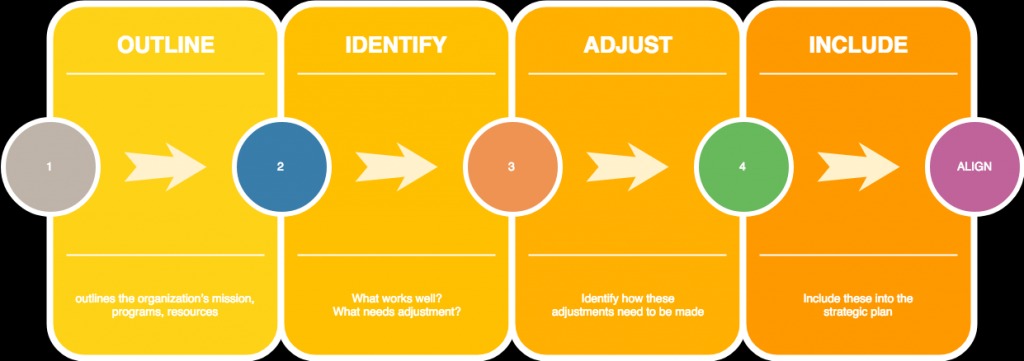
15. Organic Model Of Strategic Planning
The organic model takes an unconventional approach because it focuses on the organization’s vision and values, versus plans and processes. With this model, a company uses “natural,” self-organizing systems that originate from its values and then leverages its own resources to achieve goals, conserve funds, and operate effectively.
The organic model takes an unconventional approach because it focuses on the organization’s vision and values, versus plans and processes.CLICK TO TWEET
In the simplest form, there are three basic steps to follow when implementing the organic model of strategic planning:
Stakeholders clarify vision and values. This is a collaborative process that could involve both external and internal stakeholders—who’s in the meeting depends entirely on your organization’s ultimate purpose for the planning. The goal is to establish common visions and values for all stakeholders.
Stakeholders create personal action plans. The unconventional aspect of this model comes into play here. Divided into small groups, stakeholders determine the actions and responsibilities for each person to work toward the vision (according to the values).
Stakeholders report results of action plans. Each person will take ownership of their plan and update the group on their progress. This is a communal approach to accountability and the progress reported can lean toward qualitative, versus quantitative, results.
What type of company would the organic strategic planning model work best for? If your organization has a large, diverse group of stakeholders that need to find common ground, a vision that will take a long time to achieve, and a strong strategic emphasis on vision and values (instead of structure and procedures), this may be the right model for you. It would also be beneficial for younger organizations that need to gain funding without presenting a formal strategic plan.

16. Real-Time Strategic Planning
Similar to the organic model, real-time strategic planning is a fluid, nontraditional system. It’s primarily used by organizations that need to be more reactive, and perform strategic planning in “real time.” For these companies, detailed, long-term plans tend to become irrelevant within the typical three- to five-year planning cycle because the environment they operate in rapidly changes. Many nonprofits use this model—for example, a disaster relief agency needs the ability to respond quickly and adapt its strategy to immediately address a crisis.
Real-time strategic planning involves three levels of strategy: organizational, programmatic, and operational. For the first level, you’ll define the organization’s mission, vision, market position, competitors, trends, etc. Then, the programmatic strategy requires research into the external environment to identify approaches and offerings that would help the organization achieve its mission. The research should cover opportunities, threats, competitive advantages, and other points to spur strategic brainstorming.
The final operational level analyzes internal processes, systems, and personnel to develop a strategy that addresses “in-house” strengths and weaknesses. Looking at all three levels as a whole, strategy leaders can form criteria for developing, testing, implementing, and adapting strategies on an ongoing basis, allowing for quick and thoughtful responses when needed.
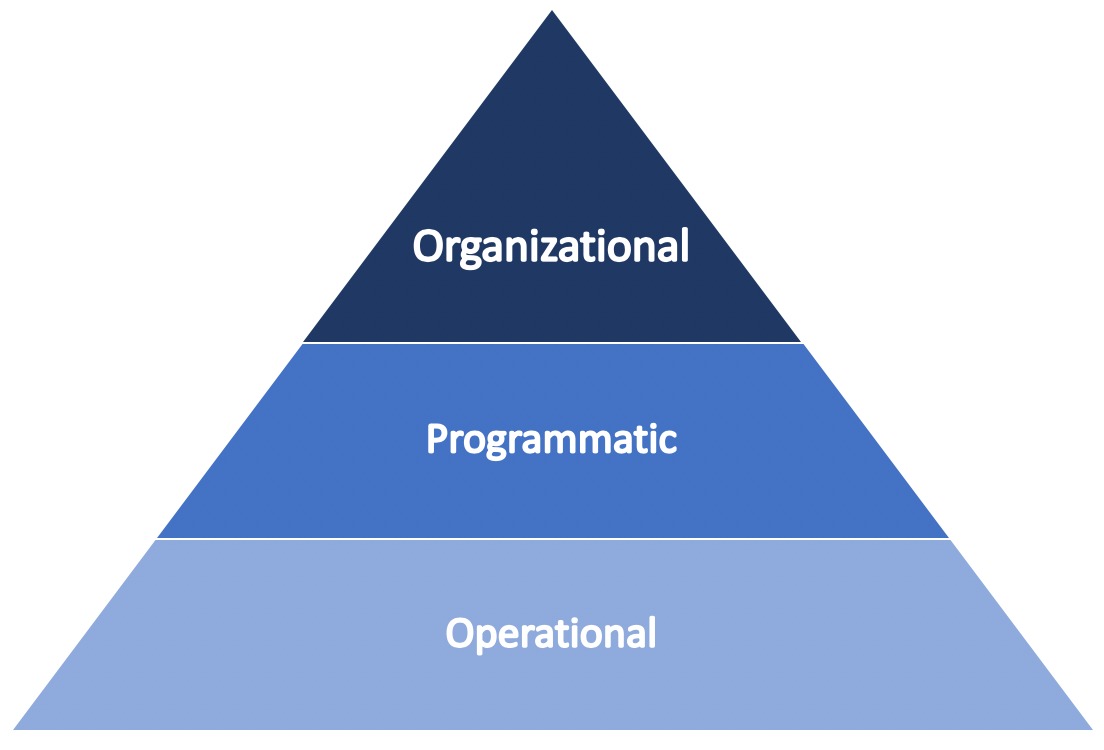
Is one strategic planning model better than the others?
That’s a great question—and the answer isn’t cut and dried. Some of these frameworks have been around longer than others, or have been used in various case studies in different ways. And sometimes managers are more comfortable with one over another, for any number of reasons.
We recommend determining which of these strategic planning models applies most to your organization’s way of thinking. For example, if you still need to work out your vision statement, it may be wise to begin with the VRIO framework and then move to something like the Balanced Scorecard to track and manage your ongoing strategy.
If you are set on pitching a particular strategic planning model to management, be prepared to give your boss or board of directors an example of another successful company that has utilized that particular model. An actual demonstration of success will make a somewhat abstract concept become more concrete.
If you are evaluating different approaches, I would recommend thinking about both creating your strategic plan and also executing on your plan. It doesn’t do you any good to have a strategic plan and not put it to use.
17.The basic model of strategic planning
The basic model of strategic planning is the most common and simplistic approach. The basic model works well for companies that are small, do not have much time to plan, don’t need to address many serious issues, or operate in stable external environments. It also works for companies that are new to strategic planning.
The basic model is not meant for organizations with significant resources to pursue ambitious visions and goals.
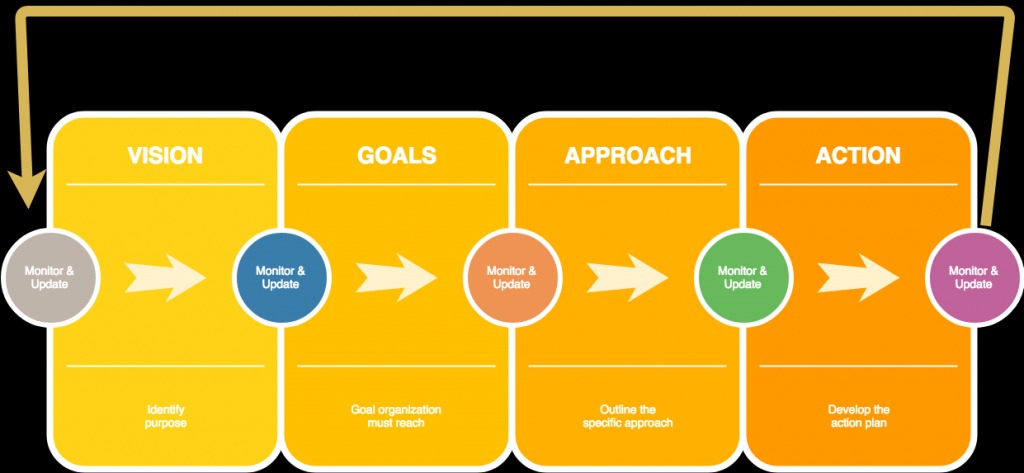
The basic model centers on the mission and vision statements. The vision statement identifies your company’s purpose on a higher level, and the mission statement outlines what happens within the organization to achieve that vision. It makes sense to build the rest of your plan from these statements.
The next step is to come up with goals you must achieve to live up to your mission and make it a reality, then outline what must happen to achieve those goals. Next, list the specific activities you must implement and who will participate in those activities. Lastly, create a simple monitoring plan to make sure your organization stays on track.
18.The scenario model
The scenario model looks at what is happening outside of an organization, including regulatory, demographic, or political forces, to determine how they can impact what is happening inside of a company.
The scenario model works best when used in combination with other models and is more of a technique than a model.

For each change in an external force, discuss how it could impact the future of your organization in the following three ways:
A best-case scenario
A worst-case scenario
A reasonable-case scenario
After looking at the three potential impacts, figure out how to best respond to each. Then pick the most likely scenario and discuss strategies to address it.
The scenario model works well for businesses that need help planning for several potential situations.
19.McKinsey’s Strategic Horizons
McKinsey’s Strategic Horizons framework focuses on growth and innovation by categorizing goals into three categories: the core business, emerging opportunities, and new business.
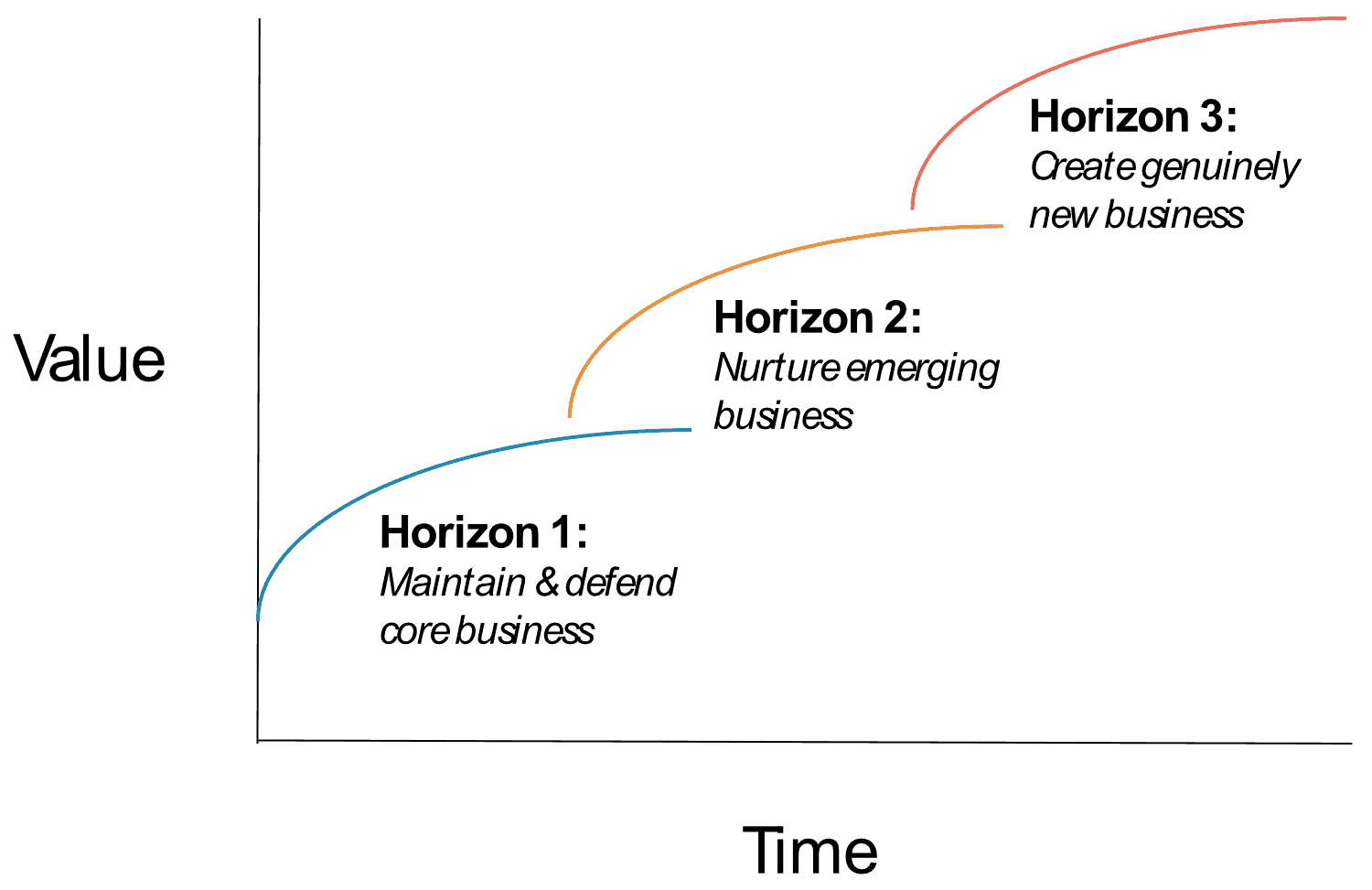
“McKinsey’s is one of my favorites because it applies to businesses small to large and generates excitement,” says Wright. He adds that it is an easy model because it does not involve much jargon and focuses on the future.
The first horizon deals mostly with core activities in which a company is already engaged. Existing revenue is placed here, so goals mostly deal with improving margins and processes, as well as maintaining incoming cash flow. The second horizon involves taking what is already happening and expanding it into new areas. The third horizon involves new directions, possibly including research and new programs. Wright recommends a 70/20/10 split between the three horizons.
Fast-growing and startup organizations might find McKinsey’s framework helpful.
20.The Bryson Model or Strategy Change Cycle
John M. Bryson, McKnight Presidential Professor of Planning and Public Affairs at the Hubert H. Humphrey School of Public Affairs, University of Minnesota and author of Strategic Planning for Public and Nonprofit Organizations: A Guide to Strengthening and Sustaining Organizational Achievement, created the Bryson model. Some people, himself included, call it the Strategy Change Cycle.
John Bryson
“It’s a framework, not a recipe. It’s a reference point, the logic does not go step by step from one to 10,” Bryson says. “You start with purposes in mind and then figure out how to get there.”
There are 10 standard steps in the cycle, but Bryson stresses they are not sequential and often happen simultaneously.
Initiate and agree on a strategic planning process
Identify organizational mandates
Clarify organizational mission and values
Assess the external and internal environment to identify strengths, weaknesses, opportunities, and threats (SWOT)
Identify the issues facing the organization
Formulate strategies to manage the issues
Review and adopt the strategies or strategic plan
Establish an effective organizational vision
Develop an effective implementation process
Reassess the strategies and the strategic planning process
Using this cycle, changes to the norm often happen. “You might think you know what your mission and goals are, and after you go through the process, you might need to change your mission and goals,” Bryson explains. “We try to let the mission and goals emerge from the conversations rather than starting there.”
Other Planning Models and Frameworks
In addition to the models and frameworks listed above, there are several other types, including the following:
The Stakeholder Theory: This approach focuses on adding value to specific groups of people, including employees, customers, the community, shareholders, and society. Organizations can add groups as necessary since the model is very flexible.
Kaufman Model: Also called mega planning, the Kaufman Model relies on a needs assessment. This model focuses on the impact an organization can have on society and clients.
Global Model: As the name implies, global strategic planning includes what is necessary to compete in an international marketplace. It involves looking at both the internal and external environments of multinational organizations.
Maturity Model: The maturity model assesses how strategic management is working within an organization and how it stands up to other organizations.
Diamond-E Framework: The Diamond-E framework helps identify possible gaps in an organization to decide whether or not to pursue an opportunity.
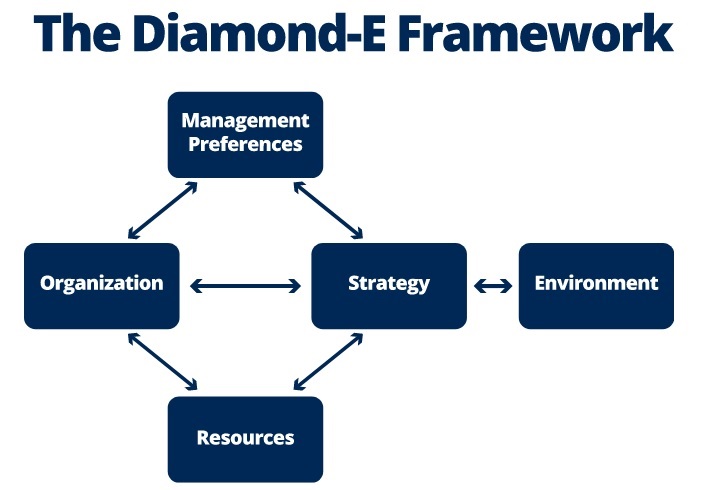
Strategic Planning Models Diamond E Framework
Value Migration: This model helps companies plan ahead of the competition. Its creator, Adrian Slywotzky, defines value migration as the shifting of forces that create value, and that shift goes from an outdated business model to a better-designed model that satisfies customers.
Value Disciplines: This flexible framework focuses on what an organization is already good at and builds on it. Three areas of focus are operational excellence, customer intimacy, and product leadership.
Strategic Planning Models Value Discipline
Agile Strategic Planning Model: The flexibility of Agile planning allows for growth and change in strategic planning. The cornerstone of Agile is being able to respond quickly to change, which seems like the antithesis of strategic planning. The Agile approach to strategic planning involves reviewing and adapting your strategic plan at regular intervals and whenever conditions warrant it.
General Electric Model: Also known as the McKinsey Matrix, this model looks at the industry externally versus the internal forces. Since it helps to identify the attractiveness of an industry and a firm’s strengths, the grid can help evaluate market share and identify areas for development.
How to Decide Which Strategic Planning Model or Framework to Use
Though strategic planning has changed over the years, the need remains for organizations to have some kind of vision and mission, as well as an outline about how to achieve them.
There is no right or wrong way to decide which model or framework to use for your strategic planning process. The key is to figure out which one best applies to your company and its needs — for example, VRIO can help you create a vision statement, and BSC can help keep plans on track. Additionally, some methods work well together.
“The perfect plan is the one that actually gets done,” says Wright. “A poor plan well executed is worth more than a great plan that never gets off the ground. Most people know what they need to do; it’s getting the traction and about democratizing the process. Constantly, people undervalue the role of buy-in with strategic planning. People need to be involved.”
“The framework you choose would have to deal with the sophistication of your business,” says Ted Jackson, founder and managing partner of ClearPoint Strategy. He recommends adapting a model or framework to meet your needs, rather than attempting to stick to hard and fast rules that might come from a book or a similar source. “I think if you read a book and try to implement it exactly [as the book outlines it] to your organization, you will fail,” he says.
Jackson advises simplifying some frameworks and adapting them, but he has some cautionary advice about trying to combine parts of different frameworks. “One mistake is not picking one framework. You can’t be so flexible that you’re implementing multiple frameworks together. People within an organization get really confused,” Jackson says, adding that people who have some knowledge of specific models or frameworks will not understand different terms and ideas, and they’ll probably be afraid to ask.
Some organizations might not get to choose the framework they use. For example, governmental organizations or companies that receive grant funding might need to produce a strategic plan that fits into a formula the government dictates.
Even though you should not use a strategic plan solely because a similar company does, it might help to look at their preferred framework to pick the one that is right for you.
Below are other criteria to help you decide:
Check the size of your organization and the resources you can devote to planning.
If your organization is in trouble, you might want to focus on a framework or model that addresses immediate issues rather than tackles the longer term.
Look at the health of your organization and its developmental stage.
See who is excited about the planning process.
“If you have a cultural challenge in your organization about getting excited about planning, the model you pick is important. Some models are sexier than others,” Wright explains.
Wright does not recommend changing models during the planning process. “[The model] is a template you use to get your ideas on paper. The model is just a vehicle. If you’re struggling with the model, it might be you.”
It isn’t the same for frameworks, according to Wright. “There is a ton of value in changing frameworks and using multiple frameworks at the same time [to view things differently],” he says. Though Wright encourages using different frameworks, he echoes Jackson’s warning to not use different models at the same time.
In certain cases, strategic planning is not an immediate need — for instance, when a company is failing financially or is autocratic, or when a major upheaval is occurring.
references:
clearpointstrategy.com
CASCADE.com
lucidchart.com


